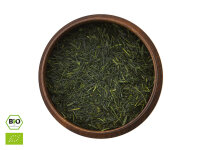
Gyokuro Tea
Gyokuro - Japan's Finest Green Tea
Gyokuro is characterized by its intense aroma and abundant umami, with a well-balanced, slightly sweet taste. It is one of the highest-quality teas in Japan. This tea is also known as shade-grown tea. Full shading is done 14 - 28 days before the first harvest by using large nets to cover the tea plants. The shading period is about twice as long as that of Kabusecha. This slows down leaf growth and increases the concentration of nutrients. After harvesting, Gyokuro leaves are gently steamed and rolled into fine, thin needles. The harvesting process is identical to that of Sencha.
Gyokuro in Organic Quality at ORYOKI
Oftentimes, particularly flavorful and intense Gyokuro teas are not certified organic. This is because the shading process places specific demands on the care of tea plants and pest control. Only a few tea farmers manage to produce high-quality, good Gyokuro teas under the strict conditions of certification. Our Gyokuro teas from Japan - Kirishima, Shizuoka, and Kagoshima - belong to this category.
What Does Gyokuro Taste Like?
The taste of this tea is unique. Gyokuro activates the fifth, lesser-known quality of our sense of taste: Umami. In the early 20th century, a Japanese researcher discovered Umami, expanding the existing taste categories of Sweet, Sour, Salty, and Bitter to include another: Savory, Delicious. With Umami, we recognize foods that are particularly rich in proteins. So, Gyokuro has a savory taste combined with a mild sweetness. Its fruity aroma gradually intensifies. To fully appreciate this flavor, correct preparation is crucial.
The "Right" Preparation of Gyokuro
To achieve the desired full Umami flavor, we recommend preparing it at 50 - 60°C. For dosing, we suggest approximately one to two teaspoons of Gyokuro per 60 ml of water. Boiling water should be cooled to around 55°C since too hot water significantly increases the bitterness (Nigami) of the tea. The steeping time for the first infusion ranges from 1.5 to 5 minutes. The cooler the water, the longer Gyokuro can steep and develop its flavor. Ensure that the tea leaves have opened sufficiently and adjust the steeping time accordingly. For the second and third infusions, the steeping time should be much shorter, about 15 - 30 seconds each.
In Japan, it's also common to consume the tea leaves after drinking the tea. A typical method is to season the green tea leaves with a bit of soy sauce and enjoy them Japanese-style, using chopsticks. This way, you can extract all the valuable nutrients from the leaves.
In the summer, Gyokuro tea can also be prepared with ice, at 0°C. The steeping time is significantly extended here because it takes longer for the water to absorb the substances from the tea leaves. This variation is a wonderful refreshment in hot temperatures.






The Health Benefits of Gyokuro
The components of Gyokuro tea are excellent for our health. Due to reduced sunlight exposure, more amino acids, specifically L-Theanine, are retained in the tea. L-Theanine is rare in other foods and has a calming, stress-reducing effect. Additionally, green tea contains a lot of chlorophyll, caffeine, and other valuable minerals.
Gyokuro's health-promoting effects include improving overall well-being, metabolism, kidney function, concentration, memory, heart and circulatory system, and digestive functions. It is recommended to drink Gyokuro, especially in the morning, before meditating and engaging in strenuous activities.
The Price of Japanese Tea
The elaborate production process, shading, and more intensive care of the tea make this green tea relatively expensive. High-quality Japanese green teas can be more affordable when opting for other green tea varieties. Kabusecha, for example, is a premium, partially shaded green tea that combines the health and flavor characteristics of Sencha and Gyokuro teas.
Enjoying Gyokuro as in Japan
For tea enthusiasts, especially those for whom green tea plays a significant role, the question of which teapot offers the best tea experience arises relatively soon. For high-quality green teas, the original clay teapot (Kyusu) is traditionally the ideal choice. The Yokode Kyusu, a side-handled teapot, is the most commonly used type. In our selection, you'll find a good variety of handcrafted side-handled teapots by Japanese masters.
Porcelain teapots, a good and beautiful material for this purpose, are also used in Japan. They are often crafted by hand using traditional methods. We also offer porcelain teapots from Japanese porcelain in our range. Our green tea pot, So-So, has won design awards and is a very decorative representative of porcelain teapots. Here, the porcelain is of very high quality, thin, and slightly transparent.
The black cast iron teapots, Arare and Hira Arare, stand out due to their style and appearance. It is particularly important for health to ensure that you are purchasing originals. Unfortunately, there are often poor-quality imitations at low prices, and the cast iron of these teapots is usually not beneficial for health!







